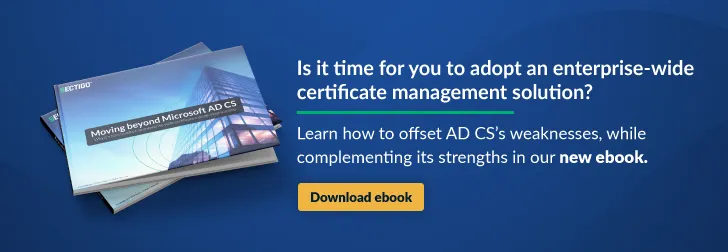Bridging the gap: Risks of partial visibility in certificate lifecycle management


Optimize digital security with unified certificate management for seamless control and reduced risks in the certificate lifecycle.
Organizations are increasingly reliant on secure connections and data protection, and the management of certificates plays a crucial role in achieving digital security. However, a common challenge faced by many enterprises is the division between public-facing and internal certificate management, often handled by separate teams. This division leads to partial visibility and communication gaps that expose organizations to various risks in certificate lifecycle management.
The divide and conquer approach
In most organizations, the responsibility for public and private certificate management is divided across different teams. Public certificates, which secure external domains and sites, are typically managed by Network Operations (NetOps) or Security teams. Private certificates, often associated with Active Directory Certificate Services (AD CS), are Windows Server administrators' domain.
This siloed approach creates visibility and communication challenges. Teams may lack insight into each other's processes, leading to critical information slipping through the cracks. Certificates may be renewed inconsistently, or worse, allowed to expire without proper notification. Additionally, when team members leave, knowledge transfer becomes a significant hurdle.
Manual tracking methods: a fragile foundation
To bridge the gap, IT administrators resort to manual tracking methods, such as spreadsheets or SharePoint lists. While these makeshift solutions are better than having no tracking mechanism at all, they come with significant limitations:
- No Central Repository: Information is siloed in fragmented tracking documents.
- Labor-Intensive: Compiling and updating these documents is time-consuming and prone to errors.
- Unnecessary Risk: Introducing mistakes undermines the trustworthiness of the certificate management process.
- Limited Alerting: It is difficult to surface crucial details like expiration alerts.
Without automation, administrators must manually review hundreds or even thousands of certificates regularly, increasing the likelihood of missing important dates and renewals. The consequence is potential outages if actively used certificates unexpectedly expire.
Renewal risks and compliance challenges
Renewing certificates poses additional challenges, especially when using Microsoft AD CS. The lack of built-in monitoring and expiration notifications means administrators must set up their own manual monitoring to track certificates nearing expiration. Renewals must also be triggered and approved manually, leaving room for oversight.
Short-lived certificates, such as those used in browsers, are particularly prone to premature expiration. Meeting the demands of auditors and regulators for strong reporting and logs to demonstrate certificate program compliance becomes a daunting task, as AD CS offers minimal built-in reporting. Piecing together audit trails from fragmented manual records becomes tedious, making compliance riskier.
Centralized visibility and lifecycle automation
To address these risks effectively, organizations need a unified view of all their certificates—both public and private, Microsoft-issued and from other Certificate Authorities (CAs). A centralized certificate management platform provides total visibility by discovering certificates across the entire network, giving administrators a single pane of glass to track and manage every certificate from one system.
Automating the certificate lifecycle is equally crucial. Automation ensures that mundane tasks like issuance, renewal, and expiration alerts happen seamlessly in the background without requiring constant administrative intervention. Key aspects of automation include auto-discovery to detect all certificates from any source, bulk renewals and provisions based on policies, notifications when certificates near expiration, and consolidated logs and reports for auditing.
The path forward: eliminating blind spots and mitigating risks
With complete visibility and automation, organizations can:
- Eliminate Blind Spots: Centralized management removes silos, providing a holistic view of the entire certificate landscape.
- Proactively Renew Certificates: Automated alerts and bulk renewals help organizations avoid outages by staying ahead of expiration dates.
- Maintain Compliance: Strong audit trails and consolidated reports facilitate compliance with regulatory requirements.
- Reduce Manual Labor: Automation allows administrators to focus on higher-value tasks, reducing the risk of human error.

By filling the gaps in certificate visibility and lifecycle management, organizations can securely embrace heterogeneous environments without adding unnecessary risks or incurring costly overhead. This approach not only prevents certificates from becoming ticking time bombs but also instills confidence that the organization meets security and compliance requirements, ultimately safeguarding against the ever-evolving threat landscape.
Learn more about Sectigo Certificate Manager, our universal platform purpose built to manage the lifecycles of digital certificates to secure every human and machine identity across your enterprise, all from a single interface Sectigo Certificate Manager.